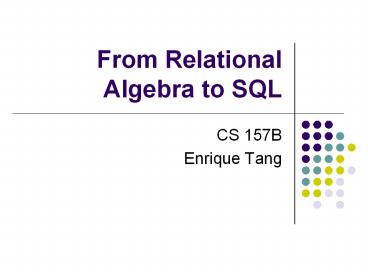From Relational Algebra to SQL PowerPoint PPT Presentation
1 / 15
Title: From Relational Algebra to SQL
1
From Relational Algebra to SQL
- CS 157B
- Enrique Tang
2
Topics
- Relational Algebra Definition
- Operations
- Translation to SQL
3
Relational Algebra DefinedTuple
- An ordered set of data values.
- a1 , a2 , a3 , , an
4
Relational Algebra Defined Relation
- A set of tuples.
- a1, a2, a3, , an ,
- b1, b2, b3, , bn ,
- c1, c2, c3 , , cn ,
- .
- .
5
Relational Algebra Defined Algebra
- Any formal mathematical system consisting of a
set of objects and operations on those objects. - Based on operators and a domain of values
- Operators map arguments from domain into another
domain value - Example x 3.5 y
6
Relational Algebra Defined Relational Algebra
- An algebra whose objects are relations and whose
operators transform relations into other
relations. - Domain set of relations, i.e., result is another
relation - Basic operators select, project, union, set
difference, Cartesian product (or cross product)
7
Relational Algebra DefinedWhere is it in DBMS?
Optimized Relational algebra expression
Relational algebra expression
Query execution plan
Executable code
SQL
Code generator
parser
Query optimizer
DBMS
8
Operations (Unary)Selection, Projection
- Selection ? ltcondition(s)gt (ltrelationgt)
- Picks tuples from the relation
- Projection ? ltattribute-listgt (ltrelationgt)
- Picks columns from the relation
9
Operations (Set)Union, Set Difference
- Union (ltrelationgt) U (ltrelationgt)
- New relation contains all tuples from both
relations, duplicate tuples eliminated. - Set Difference R S
- Produces a relation with tuples that are in R but
NOT in S.
10
Operations (Set)Cartesian Product, Intersect
- Cartesian Product R x S
- Produces a relation that is concatenation of
every tuple of R with every tuple of S - The Above operations are the 5 fundamental
operations of relational algebra. - Intersection R S
- All tuples that are in both R and S
11
Operations (Join)Theta Join, Natural Join
- Theta Join R F S ? F (R x S)
- Select all tuples from the Cartesian product of
the two relations, matching condition F - When F contains only equality , it is called
Equijoin - Natural Join R S
- Equijoin with common attributes eliminated
12
OperationsOuter Join, Semi Join
- (left) Outer Join R S
- Natural join relations while preserving all
tuples from the outer side -gt NULL values
incurred. - Semi Join R F S ?A (R F S)
- Join two relations and only keeps the attributes
seem in relation R - There are Semi-Theta Join, Semi-Equijoin and
Semi-Natural Join
13
OperationsDivision
- Division R S
- Produce a relation consist of the set of tuples
from R that matches the combination of every
tuple in S R
S RS - T1 ? ?c (R)
- T2 ? ?c ((SxT1)R)
- T ? T1 T2
14
Translation to SQL
- FROM clause produces Cartesian product (x) of
listed tables - WHERE clause assigns rows to C in sequence and
produces table containing only rows satisfying
condition ( sort of like ? ) - SELECT clause retains listed columns (? )
15
Translation to SQL (Cont.)
- SELECT C.CrsName
- FROM Course C, Teaching T
- WHERE C.CrsCodeT.CrsCode AND T.SemF2003
- List CS courses taught in F2003
- Tuple variables clarify meaning.
- Join condition C.CrsCodeT.CrsCode
- eliminates garbage
- Selection condition T.SemF2003
- eliminates irrelevant rows
- Equivalent (using natural join) to
- ?CrsName(Course ?SemF2003 (Teaching)
) - ?CrsName (?SemF2003 (Course
Teaching) )

